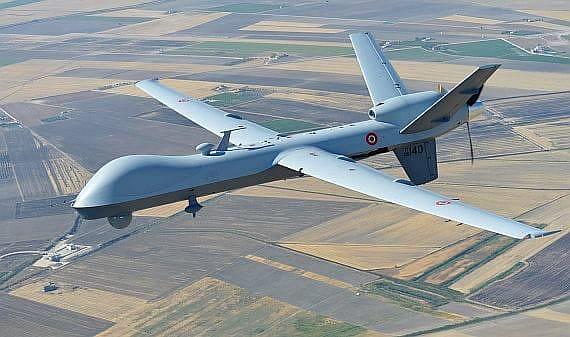New NATO drones: from the High North to the Sahel, from the Middle East to the Atlantic
Rick Rozoff
The North Atlantic Treaty Organization recently announced that it has activated a new fleet of long-range drones based in Sicily that provide “NATO an intelligence-gathering boost from the Arctic to western Africa,” according to officials of the global military bloc. The significance of the two locations, the two parameters, will be discussed later.
Carried away with the grandiose rhetoric of globalist megalomania, NATO Secretary General Jens Stoltenberg, while touting the new drones’ ability to fly for over thirty hours at a time, added to the description of their reach by boasting that they enable NATO to “cover the whole Euro-Atlantic area, from the High North to the Sahel, from the Middle East to the Atlantic.”
There was a time, 71 years ago, when the North Atlantic Treaty Organization was a twelve-member military alliance which, except for Italy, consisted of nations somewhere in the general vicinity of the North Atlantic Ocean. Now it has thirty full members, three-fifths of which are not near the Atlantic Ocean, North or otherwise, and at least forty partners around the world.
The new NATO drone, designated the AGS NATO RQ-4D, is a variation of the U.S. Block 40 Global Hawk model. Five of those are now based at the Naval Air Station Sigonella in Sicily.
The government of South Ossetia, which was invaded by Georgia in 2008 with the military assistance of the U.S. and NATO (the U.S. airlifted all 2,300 Georgian troops in Iraq home to be deployed against Russian forces), thereby triggering the Russian-Georgian war of August of that year, recently disclosed this:
“[On] January 14, 21, the border authorities recorded flights of the American Global Hawk RQ-4D drone conducting aerial reconnaissance near the southern borders of Russia and South Ossetia. The UAV took off from the NATO airbase.’Sigonella’ (Sicily, Italy), passed south of the South Ossetian-Georgian and Russian-Georgian state borders over the territory of the territories of Shida-Kartli, Mtskheta-Mtianeti and Kakheti.”
The South Ossetian authorities were laudably well-informed on the matter.
NATO chief Stoltenberg praised the drones, modified from the American original to accommodate NATO requirements, as “among the world’s most advanced reconnaissance drones, providing world-class intelligence, surveillance and reconnaissance to the Alliance.”
Contrary to pat assurances from Western leaders that there are no such things as NATO equipment, commands, bases and military units – that there are only individual member-state components – the RQ-4D unmanned aerial vehicle, like fourteen Boeing E-3 Sentry airborne early warning and control jets, are owned and operated by NATO itself, collectively.
Stars and Stripes revealed that “the alliance can also send the drones beyond Europe’s borders,” as though that wasn’t a key purpose of them, and Stoltenberg is again quoted as saying: “Allies will determine what missions (the drones) can support, but I would expect most flights to be along the alliance’s eastern and southern borders.” NATO has a liberal concept of borders, as the earlier references to Western Africa, the Sahel, the Middle East and the North Pole would indicate.
The Stars and Stripes feature on the new drones ends with this pithy and significant paragraph:
“In recent years, the military bloc has stepped up its reconnaissance and surveillance capabilities, especially in areas where NATO has been concerned about potential Russian aggression. The U.S. has attack drones based in Poland and also in January began an Air Force MQ-9 Reaper drone mission in Romania.”
====
Regarding the allusion by NATO to its newly-acquired ability to monitor developments from the Arctic to western Africa, and not to engage in once-voguish vagaries about petro-politics (peak oil crisis, “no war for oil,” Pipelineistan and suchlike notions of fond memory), it may be worth recalling that the U.S. Geological Survey several years ago estimated that the Arctic region contained approximately 90 billion barrels of undiscovered oil, 17 trillion cubic feet of undiscovered gas and 44 billion barrels of natural gas liquids, accounting for 30% of the world’s undiscovered natural gas, 22% of the world’s undiscovered oil and natural gas combined, 16% of global undiscovered oil and 26% of the world’s undiscovered liquid natural gas.
Western Africa is almost certainly an allusion to the Gulf of Guinea, where U.S. Navy Europe and the Sixth Fleet began regular visits and exercises at the beginning of this century on the initiative of, among others, then-U.S. European Command commander and NATO Supreme Allied Commander Europe Marine Corps General James Jones. The U.S. military presence in the Gulf of Guinea was the foundation of U.S. African Command.
In 2009 the Financial Times cited American government officials estimated that within six years the U.S. would receive 25% of all its oil imports from that region. As far back as 2006 the U.S. Geological Survey estimated the Gulf of Guinea to contain 1,004 million barrels of undiscovered oil, 10,071 billion cubic feet of gas, and 282 million barrels of natural gas.
Perhaps NATO has other objectives than merely “protecting its eastern and southern flanks.”

